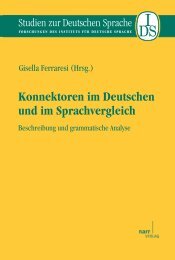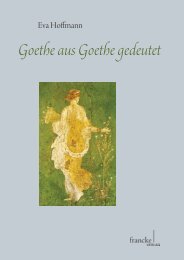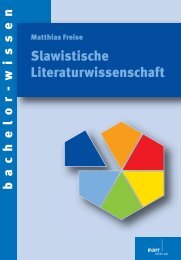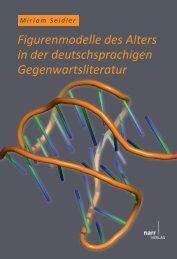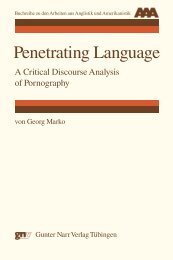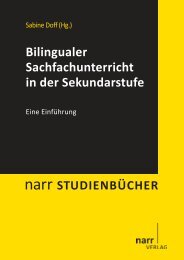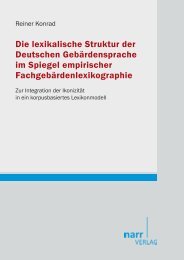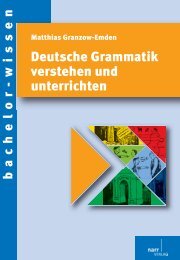Phraseologie. global - areal - regional - im Shop von Narr Francke ...
Phraseologie. global - areal - regional - im Shop von Narr Francke ...
Phraseologie. global - areal - regional - im Shop von Narr Francke ...
You also want an ePaper? Increase the reach of your titles
YUMPU automatically turns print PDFs into web optimized ePapers that Google loves.
Foreword<br />
The German Department of the University of Helsinki and the European Society of Phraseology,<br />
supported by the Finnish DAAD Alumni Club, hosted an international conference in Helsinki on<br />
August 13-16, 2008. The topic was “Phraseology <strong>global</strong> – <strong>areal</strong> – <strong>regional</strong>” (= EUROPHRAS<br />
2008). Over 200 people from 34 countries participated in the two-part conference. Part 1 was a<br />
symposium on the topic “Languages and Cultures under the Pressure of Globalization: Phraseology<br />
– a Burden or a Benefit?” Part 2 consisted of EUROPHRAS sections and a workshop entitled<br />
“Collocations in Specialized Discourses”. The symposium program, part of the festivities celebrating<br />
the 100 th anniversary of the Finnish Academy of Science and Letters, consisted of seven<br />
lectures on the central theme of how the phraseology of certain languages influences others. Following<br />
these lectures there were seven s<strong>im</strong>ultaneous sections about the origin, development,<br />
structure and use of phraseologisms within individual languages as well as comparisons and contrasts<br />
of multiple languages. In total there were 162 presentations in the sections and workshop<br />
(for further information about the conference as such please see the two reports by Annikki Li<strong>im</strong>atainen/Ulrike<br />
Richter-Vapaatalo at: http://www.europhras.org/bulletin/Europhras_Bulletin_Gesamt_2009.pdf,<br />
pp. 7-11 and by Antje Heine et al. in: Neuphilologische Mitteilungen 110, pp.<br />
255-263).<br />
As the publication of all presentations from the EUROPHRAS 2008 is not possible pr<strong>im</strong>arily<br />
due to financial reasons, the organizers came to the following decision: A selection of presentations<br />
which are directly related to the central theme or show a contrast or comparison between<br />
various languages or language varieties will be included in an essay volume. Additional presentations<br />
will be published on the internet. Furthermore, after the conference several colleagues<br />
agreed to edit their own essay volumes in addition to the workshop in the following areas: routine<br />
formulas, phraseology in literary texts and computer-supported phraseology. A total of 98 contributions<br />
were submitted to the organizers for publication.<br />
After an appraisal and consultation among the editors, 43 articles were accepted for this essay<br />
volume. The selection of articles was based on contextual and qualitative criteria as well as the<br />
inclusion of as many language families as possible (Germanic, Slavic, Romance, etc.). The essay<br />
volume consists of two parts: I. Phraseology <strong>global</strong> – <strong>areal</strong> – <strong>regional</strong> and II. Contrastive and<br />
comparative phraseology. At the beginning of the first part are the seven symposium lectures.<br />
Following these are articles in which phraseology is examined from a <strong>global</strong> viewpoint, with the<br />
<strong>global</strong> aspect at t<strong>im</strong>es being supplemented by <strong>areal</strong> and/or <strong>regional</strong> aspects. Next are articles in<br />
which <strong>global</strong>ization is understood as one language borrowing phraseologisms from another. At<br />
the end of part I are articles focusing on <strong>areal</strong> or <strong>regional</strong> aspects of phraseology. Part II opens<br />
with contrastive articles. First is an article contrasting three languages, the following articles all<br />
contrast two languages. The order of articles dealing with two languages was based on membership<br />
of the examined languages to specific language families. In most articles a Germanic language<br />
(pr<strong>im</strong>arily German) is contrasted with a Slavic or Romance language, which is the reason<br />
they were given precedence. The arrangement of the second section of part II, i. e. the group of<br />
comparative articles, is s<strong>im</strong>ilar to the first section. At the beginning there are articles dealing with<br />
multiple languages, followed by articles about two languages. Again the German language has a<br />
central role in these articles.





